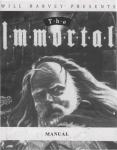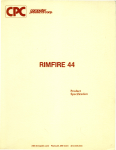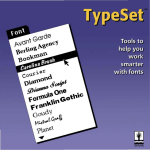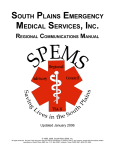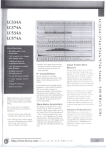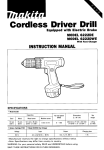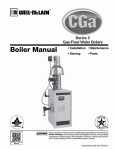Download MSU Extension Publication Archive Scroll down to
Transcript
MSU Extension Publication Archive
Archive copy of publication, do not use for current recommendations. Up-to-date
information about many topics can be obtained from your local Extension office.
Planning Winter Sports Areas
Michigan State University Extension
Tourism Resort Series Circular Bulletin
C. A. Gunn
Issued October 1958
12 pages
The PDF file was provided courtesy of the Michigan State University Library
Scroll down to view the publication.
Tourist ' and Resort Series
,
Cooperative 'E;;:nsion Service
~
LOCATION
~
SITE
SELECTION
~
SITE
PLANNING
~
BUILDING
PLANNING
FOREWORD
The recent boom demand for winter enjoyment in :M ichigan has stimulated the growth of winter sports areas throughout the state. Areas in
existence ten years ago have now expanded greatly while the number of
areas in the state has increased over ten tin1es in the SaIne period.
A natural corollary of this growth has been the increasing need for
guidance in the physical development of properties. The experience and
ingenuity of skilled skiers and operators of successful businesses elsewhere,
as well as in Michigan, have resulted in the establishment of some very
fine winter sports areas in this state.
Even so, much of the developlnent has been on a trial-anu-error basis.
11any operators have paid severely for their mistakes. Several have indicated that if they were to do it again, they would pe more careful in the
selection of a location. Therefore, a study of the problems of location, site
selection, site development, and building design was begun. The results
of this research, together with recommendations for development are
herein presented.
The intent of this publication is to take some of the guesswork out of
future expansion of present businesses or development of new ones. It is
not intended to promote the establishment of new areas. This information
should be of equal help to present and prospective operators, all those connected with the development of winter sports areas, such as landscape
architects, architects, realtors, land planners, tourist and resort organizations, and the suppliers of products and equipn1ent.
ACKNOWLEDGMENTS
The author wishes to express sincere appreciation to all those who so
willingly cooperated in supplying information, recomn1endations, and comments which made this circular possible. Special credit should go to those
people who are so well inforIned on winter sports development, such as
Ben Van Sant, ski business consultant; Frank Dunham, publisher, Skier;
and Stan DuRose, chairman engineering committee, Central U. S. Ski
Association. Many operators of established ski areas in Michigan were
generous in their analysis and recommendations, such as O. Lynn Mead,
Sylvan Knob; Holland Capper, Manistee Ski Area; Fred Bocks, Caberfae;
Morton Graddis, Mt. Holly; Albert QuaIl, Ishpeming Winter Sports Park;
Gilbert Wells, Snow Valley; Stevie and Al Almon, Ski Village; and Jerry
Fairbanks, Au Sable Ranch and Ski Club. Among others who assisted
n1aterially in the research and preparation of this circular were George
Polich, formerly Brule Mountain; Ray ~1cMullen, Cooperative Extension
Agent, MSU; Charles Pennington, Otsego County Memorial Hospital;
Frank Davis, East Michigan Tourist Association; H. Frank Beeman, Intramural Sports, MSU; Don Thomas, sporting goods; A. H. Eichn1eier, Michigan Section, U. S. Weather Bureau; David Wilcox, Parks and Recreation
Division, Michigan Department of Conservation; Gladys Knight, MSU;
Robert McIntosh, MSU; and manufacturers of equipment for snow-making,
tows, and ski lifts.
Cover photo a nd Fig. 1.3, Michigan Tourist Council, Lansing; Figs. 1 and 2. data from U. S . Weathcr
Bureau, East Lansing ; Fig. 8, East Michigan Tourist Association, Bay C it y; Fig. 9, Ishpem in g Chamhcr Cif
Commerce; Fig. 10, Ski Patrol Manual, D enver; Fig. 11, Pomalift, Denver; Fig. 12, Skilancl Photo, Eagle
River, Wis.; Fig. 14, Hombe rg Photo, Ishpem ing; Fig. 1.5, Larchmont Farms, Lexington, Mass.; Figs. 16 and
17, West Michigan Tourist and R esort Association, Grand Rapids; Fig. 7, Echo Valley, Kalamazoo.
Planning Winter Sports Areas
By C. A. GUNN 1
INTRODUCTION
If you are considering the expansion of your
present business or establishing a new one, where
do you begin? In either case, it would seem appropriate to n1ake a critical analysis of the location and site you now own or intend to buy. Therefore, the first section of this bulletin, "Before You
Buy the Land", (below) gives YOll guidance on this
very important first step.
How do you develop the site after you are
confident you have a good one? While this requires expert and specialized help, some fundamentals are presented in, "Layout Suggestions,"
page 7.
While building design is the province of the
professional designer, a sumn1ary of building planning and construction ideas appears in "Building
Suggestions," page 11.
Application of these recommendations should
result in better planned and built winter sports
areas in Michigan. More specifically, if you are
investing in land and buildings for winter vacationists, you should: 1) obtain a Inore desirable
and profitable business for the money you invest;
2) make better use of Michigan's recreational
lands; and 3) provide better service for those who
patronize your area.
Before You Buy The Land
Winter Sports Resort-as above, with complete food service, bar (optional), lodging, and
entertainment on the site (rather than supplied by
the nearby cOlnmunity).
Year-Around Resort-as above, with attractions and facilities for vacationists during spring,
summer, and fall, as well as in winter.
DETERMINE THE TYPE OF BUSINESS
~10st winter sports businesses require similar
location and site characteristics. Some differences
do exist, however, and should be recognized before buying land. Because skiing dominates all
other activities at winter sports areas, suitable
hilly land for ski slopes is required. If however,
you hope to provide tobogganing, skating, ice fishing, or other winter sports, suitable land must be
obtained. If you intend to provide complete food
service, lodging, and entertainment on the site,
you may wish to attract guests during spring, sumIner, and fall to justify the added investment. To
do this requires a location with trout strean1S, lake
frontage, swimming beach, wild gan1e, or other
all-season attractions.
Four types of winter sports businesses are now
appearing in Michigan:
Basic Ski Center-the minimum of facilities,
providing for skiing only.
Winter Sports Center-as above, with other
sports added, such as tobogganing, skating, ice
fishing. Facilities for warming, snacks, first aid,
equipn1ent rentals, sales, and rest rooms are more
cOInplete.
SELECT THE BEST SITE
After detennining the type of enterprise you
wish to operate, you should search for the ,most
ideal site. While this Inay seem costly to you
when considering the price per acre, the cost of
the site should be related to the income it can
produce. Also, a cheap site often requires excessive land improvement (filling, grading, draining,
planting).
ADEQUATE SNOWFALL
Much of Michigan has greater snowfall than
any point between the Rocky Mountains and New
England. This unique aspect of its climate, largely
due to the influence of the surrounding Great
Lakes, makes the state very well suited to winter
sports.
l Associate Professor (Re se arch-Extension) School of Hote l, Restaurant,
and Institutional Manage m e nt, Michigan State Universit~.
3
•
Reference to Fig. 1 shows that n1uch of Michigan has over 60 inches of snowfall per year. Those
areas with lesser annual averages must depend
more upon artificially prepared snow. Snowmaking equipment is available, but the added
costs of installation, operation, and upkeep must
be justified by increased volume of business.
each category needs a separate slope. At present,
the greatest volume of patronage is from those of
little or no skiing experience. Hence, the greatest
number of slopes should be developed for beginning and intern1ediate skiers. In the future, as
n10re skiers gain in skill, the more difficult slopes
will be in greater demand.
By coincidence of its glacial history, Michigan
has hilly land in most of the areas of heavier snowfall. Obtain topographic maps to help locate a
suitable site. (See Fig. 5).
LONG WINTER SEASON
As important as snowfall is the amount of cold
weather to retain the snow. Fig. 2 illustrates
relative differences in length of winter season.
Reference to both Fig. 1 and 2 should assist in
evaluating a location regarding the influence of
weather.
ORIENTATION
~Slopes are usually e xpressed in percent, the ratio of height in feet
for 100 feet of horizontal distance , rather than degrees.
Several additional weeks of skiing are possible
on those slopes which are properly oriented to
the sun and wind.
Prevailing winter winds in j\1ichigan are from
the northwest and west. Therefore, a high percentage of snow blows away when the topography
is such that severe exposure to these winds exists.
Strong winds during severely cold weather cause
enough discomfort to discourage use of the slopes.
High ridges to the west or northwest of the areas
to be developed protect the skier and tend to
deposit more snow by slowing the velocity of
snowladen winds.
Ideally, ski slopes or toboggan runs should
face to the north or northeast to avoid damaging
effects of the sun. Some successful runs have been
made in an easterly direction, but only when
Fig. 1. An unusually heavy and non-uniform snowfall results from cold air waves sweeping down from the northwest over Lakes Superior and Michigan.
Fig. 2. The combination of semimarine and continental
types of climate results in shorter winters in the coastal
regions than in the interior.
SUITABLE AREA AND TOPOGRAPHY
A good winter sports site includes over 100
acres of both hilly and reasonably levelland. (See
Fig. 5 and 6). Skiing and tobogganing require
elevation differences of over 100 feet and slopes
fron1 10 to 60 percent 2 or over. Nearby, level (but
well-drained) land is needed for building sites,
parking areas, drives, and skating rinks.
In selecting sites for recreation skiing, three
categories of skiers need to be considered: beginners, intermediates, and experts. For safety's sake,
4
on the site, but the business will be limited severely without "high-line" power.
other factors, such as width of cleared area and
height of forest cover, were extremely favorable.
Telephone service to the site. Con1n1unication with the nearby con1n1unity and its many
business places is needed. Safety dictates communication with medical and hospital services.
Reservations and other aspects of the operation
of the business are carried on much more efficiently by telephone.
FOREST COVER
Cleared land is less desirable than forested
land. Tall forests are superior to low forest cover.
This is related to the damaging effects of both
wind and sun. With adequate forest protection,
a slope actually receives more snow as well as
retaining it for a longer period of time.
Professional guidance is helpful in selecting
locations. Expert help on topography, soils,
forests, climatology, and deep rock geology can
save thousands of dollars for the investor in winter sports facilities. Professional assistance fron1
landscape architects, architects, and engineers
may avoid poor site selection and development.
SUITABLE SOIL
Land which is rocky or filled with springs may
make development difficult or impossible. Soil
conditions should support a good grass turf on ski
slopes; have adequate drainage for good drive and
parking area construction; and be suited to good
building construction.
OTHER FACTORS
CHECK THE MARKET AND ACCESS
TO THE AREA
Sources of Water. When selecting a location
for any winter sports business, it is essential to
investigate sources of water. Water will be needed
for the many services at the central shelter, such
as the snack bar, first aid, and rest rooms. If snowmaking equipment is contemplated, quantities of
water in excess of 80 gallons-per-minute may be
needed.
Electrical power supply. MiniInum light and
water pump service can be supplied by a generator
SERVICE
GUEST
PAf2.KI/VG
PAR. KING
In contrast to the distribution of manufactured products to the consumer, winter sports
businesses depend upon the customers coming to
the areas. Therefore, the number of persons interested in winter sports, their ability to pay for
services, and the means of transporting them to
the areas become important when considering the
location of new businesses.
l
/lLLOWAMPL£
MIN
SP4CG FOR
.MAX. SNOW
75'
I
I
PARk' AT RAT!; OF <5 C4I?S
PCIZ 100'(SNOWY SUI2f:ACG)
Q
CL£412 _!
-4---4#0 10 CARS P£/2 lOa' --+----+-4-30· ~
(IDEAL CONDIT/ONS).
5K4TING
SKI JUMPS
CROSS -COU#T.l?Y
~
Ski SLOPES
ACTIVITY
A-I2EAS
TOBOGC4N RUNS
CI/ILORFN"S ./I-R£"4
Fig. 3. An area is easier and safer to use if the layout
prevents scattering by directing the flow of traffic in an
orderly manner.
O/2IVE
f
Fig. 4. Allow ample room for parking. Windrows of
snow can act as barriers. Consider drainage to prevent
icy parking after thawing and freezing .
5
i
r
q
Ski trains, popular in eastern states, do not
appear to be popular in the lower peninsula but
do contribute to business in the Upper Peninsula.
Air travel to winter sports areas is complicated
by ground travel at each tern1inal, the handling of
cumberson1e equipment, and adverse flying conditions.
While no precise prediction of future popularity can be made, present trends indicate that
young people don1inate the winter sports market. The majority of participants are from 15 to
34 years of age. Other important age groups are
teen-age children and winter vacationing families,
including pre-school children and adults over 40.
From the potential lnarket standpoint, the future
of the winter sports business looks bright considering that those in the 15 to 34 age group in
the U. S. may number 61 million by 1970, compared to 46 million today.
Logically, the younger age groups are not
able to spend as much as those who are older
and have higher incomes. However, the high
patronage in the younger age group indicates a
willingness to pay for transportation and basic tow
fees. The popularity of more cOlnplete n1eal
service, high quality roon1S, and extra services
seems to parallel increases in incon1es.
The automobile is the don1inant lneans of
transportation. Therefore, in selecting a new location, the operator must consider highway routes,
highway quality, and highway upkeep in winter.
The primary market for winter sports patronage in
Michigan lies in the metropolitan-industrial belt
frOln northern Illinois through northern Ohio.
Good highway access is also needed for those who
come to winter sports areas by bus.
Fig. 5.
INVESTIGATE NEARBY SERVICES
So far, only a small nun1ber of resorts provide
entertainment, complete food service, and lodging
at the winter sports area. The n1ajority are highly
dependent upon the nearby community for these
services.
Therefore, in selecting a location it becon1es
in1portant to survey the number and quality of establishments providing entertainn1ent, beverages,
food service, and lodging. These services are in1pOl"tant to skiers and other winter sports enthusiasts.
In addition to the cOlnn1ercial services, those
provided by agencies and organizations should be
reviewed. A more favorable location is one near a
community with good street upkeep; high standards of sanitation; active chamber of commerce;
active youth organizations; good lnedical and hospital services; and general community support of
winter resorting.
A typical contour map, helpful in determining
Fig. 6.
A site plan of a small winter sports center.
percent slope, orientation to sun and wind, and amount
Ample land must be obtained for parking, buildings,
of land for parking, buildings, and activities.
sports activities, and future expansion.
6
DEVELOP A PROSPECTUS
difficult to describe your intentions to others. It
is much easier to say to a builder, banker, or
friend, "take this report home with you and look
it over. It explains what I have in n1ind."
Furthermore, it gives all readers the impression that you are a good businessman and capable
of n1anagement because you can present your
ideas clearly and in an orderly fashion.
You are urged to develop a prospectus on the
following outline:
The minilnum investment in a winter sports
area nowdays is about $100,000. Before you seek
a lnortgage or begin spending such a Slun of
money, you should have a clear idea of the entire
project you hope to develop. Taking the time to
prepare a well-organized and complete report on
your proposed project is worthwhile for many
reasons.
First, in obtaining the facts for others to read
and understand you will have much better knowledge of your own project. Sometin1es, our enthusiasm tends to bring us to conclusions which
are not founded in fact.
Next, without a prospectus, you will find it
Analysis of the Location and Site
Proposed Layout of Development
Proposed Buildings and other Construction
Estin1ated Costs and Returns
Qualifications of Owner-~1anager
Layout Suggestions
DESIGN AND CONSTRUCTION
V Obtain the assistance of a professional skier
and a landscape architect.
\ / See Fig. 3 for a typical functional diagram.
V See Fig. 6 for a typical layout of a winter sports
area.
V The area should be easy and convenient for the
guest to use.
V The layout should lnake the area easy to maintain.
V The layout should be free frOln safety hazards.
V When properly done, the layout should be attractive and interesting.
V The layout should 111ake best use of the natural
site advantages.
>==+===J:tltt+:l~1
.
ENTRANCE, DRIVES AND PARKING
\ / Entrance should be clearly n1arked and provide
easy access from lnain highway.
,_Jii
• v
;
,i {
~"1 ';
Fig. 7. Several parallel runs, using concrete for basic
construction. Maximum speed is assured by iced chute,
sprayed nightly during season.
Fig. 8. Typical toboggan run with steel rail sides. Note
straight route and absence of dips or bumps. Proper construction and layout are needed for safety.
7
1111nlmunl of 75-foot cleared width; nlore circuitous route down is permissible.
V Slopes graded to avoid bowls, dips, bumps;
edges of clearing bordered with shrubs; good
grass turf on slopes (kept cut in sunl111er).
V Screen of plantings at base to protect skiers
waiting for tow or lift.
V Grading down toward the hill at beginning of
tow so skier is not jerked from a standstill.
V Follow specific rules of size, shape, and design
of drives and parking (see Fig. 4).
V Avoid hazardous curves or grades.
V Separate service drive and parking from public
drive and parking.
V Consider drainage to avoid icy drives and parking.
V Direct all new guests to single control point
(entrance of shelter).
SKI JUMPING
BUILDING ARRANGEMENT
V COll1petitive jumps follow specific rules of layout and design (contact the Ski Hill Engineering Committee of the NSA).::
V Provide anlple space for spectators - both
standing roonl and parking.
V Consult specialists for design of smaller noncompetitive jumps.
V Should make best use of the site.
V Building placement should allow for expansion
of both buildings and site developl11ent.
V Guest should obtain good first impression and
find his way around easily.
V Grouping should be functional for the manager.
CROSS - COUNTRY TRAILS
V
V
V
V
ACTIVITY AREAS
SKI SLOPES
V Beginners' area: not to exceed 20% slope; slow
tow for practice; isolated from experienced
skiers.
V Intenl1ediate area: 25% to 50% on steeper portions of slope; 5% to 15% on lower or out-run;
about 150 feet cleared width; reasonably direct
route down.
V Expert area: 60% or more for added challenge;
20% to 40% slope on major portion of slope;
OTHER ACTIVITIES
V Toboggan runs: layout, design, and construction
must be accurate and smooth to avoid hazards (see
Figs. 7 and 8); isolate from skiing or other activ··
"Edmund Couch, Jr., Chairman, Ski Hill Enginee ring Committee,
National Ski Association, 4 Virginia Hills Ave., Alexandria, Virginia.
,
,I
•
Not less than ten feet wide.
Slope not to exceed 10%.
Should not exceed two nliles in length.
Consider warming shelter, interconl at end of
trail.
I
l
I !
r
i ••
t " .,
Fig. 10. A positive power cut-off device is an absolute
necessity for all rope tows. Ample area for landing ahead
of safety cut-off is needed.
Fig. 9. Rope tows are very popular because of capacity,
ease of installation and low cost. Proper installation reduces rope breakage.
8
V
V
V
V
V
ities; uphill access and toboggan return by
truck or caterpillar vehicle.
Skating: on any levelland; about 85' x 200' desirable size for hockey and exhibition skating;
wood-floored shelter for warming, snacks, first
aid adjacent to skating rink.
Children's area: gentler slopes for saucers,
sleds, or "cardboard" slides (see Fig. 14); isolated
from ski slopes and toboggans for safety.
Ice fishing: an attraction in itself but seldom
patronized by those participating in skiing,
skating, or tobogganing.
Sleigh Rides, Snowshoe Trails, Viewing Wildlife: supplementary activities which require
their own special land characteristics.
Swimming Pool: an added attraction being
used by some; most satisfactory when enclosed
and heated; lTIUst be built to rigid health requirements.
V
V
V
V
V
PLATTER PULL
V Uses stock manufactured parts, but is designed
to suit specific needs of lift and capacity (see
Fig. 11).
V Higher cost than rope tow, but has less frequent breakdowns.
V Is flexible in capacity, because platters are not
fixed on cable.
UPHILL EQUIPMENT
Your selection of uphill equipment will depend
upon: initial cost; cost of operation; convenience;
site conditions; and capacity. No one type is best
for all conditions.
T-BAR
V Higher investment, but greater capacity than
Platter Pull (see Fig. 12).
V Can be purchased with option to replace
T-bars with chairs.
V Well suited to longer and higher slopes.
ROPE TOW
V Popular because of low first cost; ease of installation; capacity (see Fig. 9).
V Breakage n10st often caused by: improper
Fig. 11. Platter Pull. A durable type;
takes up one skier at a time. Capacity can be adjusted to need.
splicing; excessive surface wear caused by
dragging rope; n1isalignment of sheaves or
sheaves too small; excessive tension; and mildew, resulting from improper storage.
Long rope tows are fatiguing. MaximUll1 is
1000'.
Tow speeds are normally 15 mph; n1ay be
increased to 20 mph on steep slopes; 10 mph
on beginners' tow.
Power at top of slope is preferred.
Electric motor power is preferred, but gasoline
engine n1ay suffice if properly installed and
maintained.
All power equipment must have safety controls and positive cut-off (see Fig. 10).
Fig. 12. T-bar. A durable type
which takes up two at a time. T -bars
can be replaced with chairs.
9
Fig. 13. Chair Lift. Deluxe uphill
equipment, best suited to long and
steep slopes.
CHAIR LIFT
Y Deluxe uphill transportation (see Fig. 13).
Y Most costly of all types.
Y Skier has no contact with the ground; hence no
accidents from this cause.
Y Capacity not as great as other types.
Y
Y
Y
Y
SNOW - MAKING EQUIPMENT
The reasons given for the use of snow-making
equipn1ent are: unusual wear on ski slopes; unseasonably small amount of snowfall; favorable
ten1perature conditions but nonnally low an10lll1t
of snowfall. In any case, the cost of installation
and operation of equipment must be justified by
increased volume of business (see Fig. 15).
sports areas is controversial; investigate before
doing.)
Select equipment which will provide ample
light for each purpose.
Install equipn1ent properly so that it is safe
and eliminates glare.
Use lan1ps and wiring of proper size.
Use durable equipment-reduces early repair
or replacement.
SIGNS
Y Advertising Signs: number, size and placement
depend upon your advertising budget; should
have short, quickly read message; size of letter, color, style quickly read for distance and
time of viewing.
Y Informative Signs: whether such signs are directional, rules, or identifying, they should be
simple, clear, brief, and properly placed.
Y Equipment now uses great mnounts of water
and compressed air. Example: 80 gpm at
50-65 psi, together with air at 1,000 cfIn required to cover area 100' x 1000' with 3" of
wet snow or 6-8" light snow.
Y Air temperatures usually must be below 25 °F.
Y Consider layout of distribution piping and
placement of equipment when making layout
of slopes.
COMMUNICATIONS
Y Minimum grounds lighting needed around
buildings, parking, entrance.
Y Special layout of lighting required if sports
areas are to be used at night. (Night use of
Y Telephone service to central shelter essential.
Y IntercOln system between central shelter and
outlying services (remote shelters, power
houses for tows or lifts) depends upon distance and site conditions.
Y Public address system essential. Used for announcements, safety precautions, control, and
music during sports participation.
Y Underground transmission for electrical power
and comn1unications preferred.
Fig. 14. A cardboard slide. Hillside is graded slightly
and trough is iced in freezing weather. Children slide
down on flattened boxes.
Fig. 15. In areas of inadequate natural snowfall, but
proper temperatures, snow can be made on the site. Cost
must be justified by increased business.
LIGHTING
10
Building Suggestions
DESIGN AND CONSTRUCTION
V Obtain professional guidance on the design of
all buildings.
V Study your own needs thoroughly before contacting your architect.
V No evidence is available to prove one architectural style more successful than another.
V All designs should be appealing to all who use
the buildings, suited to snowy and icy conditions, and adapted to the setting.
V Special consideration should be given water
supply, waste disposal, plumbing, ventilation,
heating, and kitchen equipment.
V Make sure all building plans are: functional as
well as attractive; subject to low upkeep; within your building budget; and such that future
expansion will be easy (see Fig. 17).
V
V
V
THE CENTRAL SHELTER
V
V Entrance: should provide for tagging of all
new guests; information on services available;
rules of safety, and directions.
V Office: should include a business office with
counter open to public; private office for n1anagel'; room for the Ski Patrol.
V The Lounge: should have sweeping view of ac-
V
Fig. 16. The lounge traditionally must have a fireplace.
Suitable decor, durable furnishings, and adequate size
are desirable features.
tivity areas; decor which induces rest and relaxation; built to withstand rough usage ; contain a large fireplace (see Fig. 16); easily accessible and yet not disturbed by traffic.
Rest Rooms: ample number of fixtures for anticipated trade; accessible from both indoors as
well as outdoors; built to withstand h eavy use;
easy to n1aintain in sanitary condition.
Food Service: snack bar at one side of lounge
is minimum; cafeteria or dining room service
n1ay be in demand; kitchen size , equipment
and layout should be suited to type of service
anticipated; consider service entrance and storage areas; obtain special help for layout.
Equipment Rental: consider proper storage of
equipn1ent for daily rental; layout of area
should facilitate quick service; an10unt and
variety of rentals depend upon anticipated demand (in many areas, 20% of the guests use
equipment rented at the site).
Equipment Sales: opinions vary but son1e sales
space seen1S desirable; amount of space depends upon volun1e of patronage and availability of equipment elsewhere.
Equipment Repair: son1e space should be devoted to repair of ski and other winter sports
equipn1ent; usually located near equipment
rental space.
Fig. 17. A" buildings should be attractive as well as
functional, easily maintained, suitably sited, and easily
expanded in future.
11
V First Aid: accessible fron1 both inside and outside shelter; heated; hot and cold running
water; equipped with usual needs for first aid;
follow detailed recomn1endations in "Ski Patrol
V
~1anual."
V
V An1bulance: heated garage, housing station
wagon or other suitable vehicle to serve as
ambulance; readily accessible fron1 first aid
and service drive.
V
V
LODGING
V
V Young, unmarried (generally high school and
college age): dormitory type housing with sep-
arate or open sleeping rooms for one sex and
connected to a bath.
Married couples and others: prefer private
roon1S, each with cOl11plete bath.
FaI11ily groups: prefer private suites of rooms
with bath.
Before deciding upon building lodging, estin1ate the returns on the investInent; existing
motel and hotel facilities may be best solution.
For year-around resort, consider the attachment of lodging to the central dining and
lounge space.
Consider the advantages of inside corridor access to guest rooms.
SUMMARY
:Michigan has many natural advantages for winter sports activities.
Although the trial and error n1ethod has been
used to date (and some very fine areas do exist)
n10st operators agree that a n10re scientific approach should be made when expanding present
facilities or developing new ones.
Before buying the land, one should consider:
the type of business to enter; the n10st desirable
site characteristics; the market and access to the
area; the availability of other services nearby;
and prepare a con1plete prospectus of the business. This will avoid costly errors and will result
in the development of only those lands best suited
to this use.
When properly planned, the layout should
111ake the area easy to use and maintain, be attractive in appearance, and allow for expansion
of facilities.
All buildings should be functional as well
as attractive; subject to low upkeep; within your
building budget; and such that future expansion
will be easy.
SEE ALSO
U. S. Geological Survey Maps of many areas of Michigan
which indicate the topography with contour lines. Contact the Geological Survey Division, Michigan Department of Conservation, Lansing.
Ski Shop Bible. A directory of equipment and products
relating to skiing. Published annually by the Ski Magazine, Hanover, New Hampshire.
Ski Patrol Manual. A guide for proper operation of ski
areas; the National Ski Patrol System; safety considerations in layout, construction and equipment. Issued by
the National Ski Association of America, 1130 16th St.,
Denver 2, Colorado.
Dependable, Economical TOllis. A commercial bulletin,
describing the design and construction of rope tow
equipment. Columbian Hope Company, Auburn, New
York.
Ski lniuries - Their Prevention. A paper presented by
Vernon D. E. Smith, M.D., F.A.C.S., St. Paul, Minnesota, and printed in Bulletin, American College of Surgeons, September - October, 19.5.5.
Sofetu Standards fOT Ski TOllis and Lifts.
An excerpt from
Forest Service Manual, Vol. 3, Sec. G . Prepared by
the U. S. Forest Service, Washington, D.C.
The Skier, a midwest paper published at Corunna, Michigan.
Ski Maga:::.ine, a nationwide publication, Hanover, New
Hampshire.
For further information, consult your county cooperative extension agent, or write to the Tourist and Resort Service, Kellogg Center, Michigan State University, East Lansing, Michigan.
Cooperative extens ion work in agriculture and home eco nomics. Michigan State University and the U.S. Dqwrtlllent of Agl-iClllturc cooperating.
Paul A. Miller, Director, Cooperative Extension Service, Michigan State University, East Lansing. Printed and distributed under Acts of Congress, May
8 and June 30, 1914.
10:S8-.5M
12














